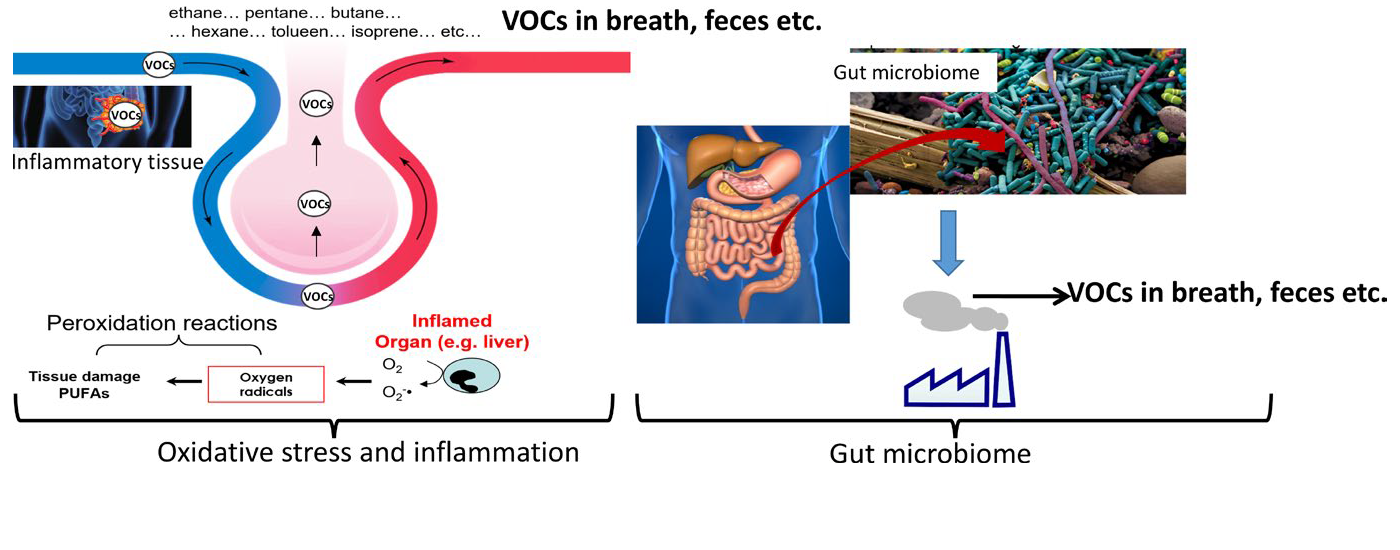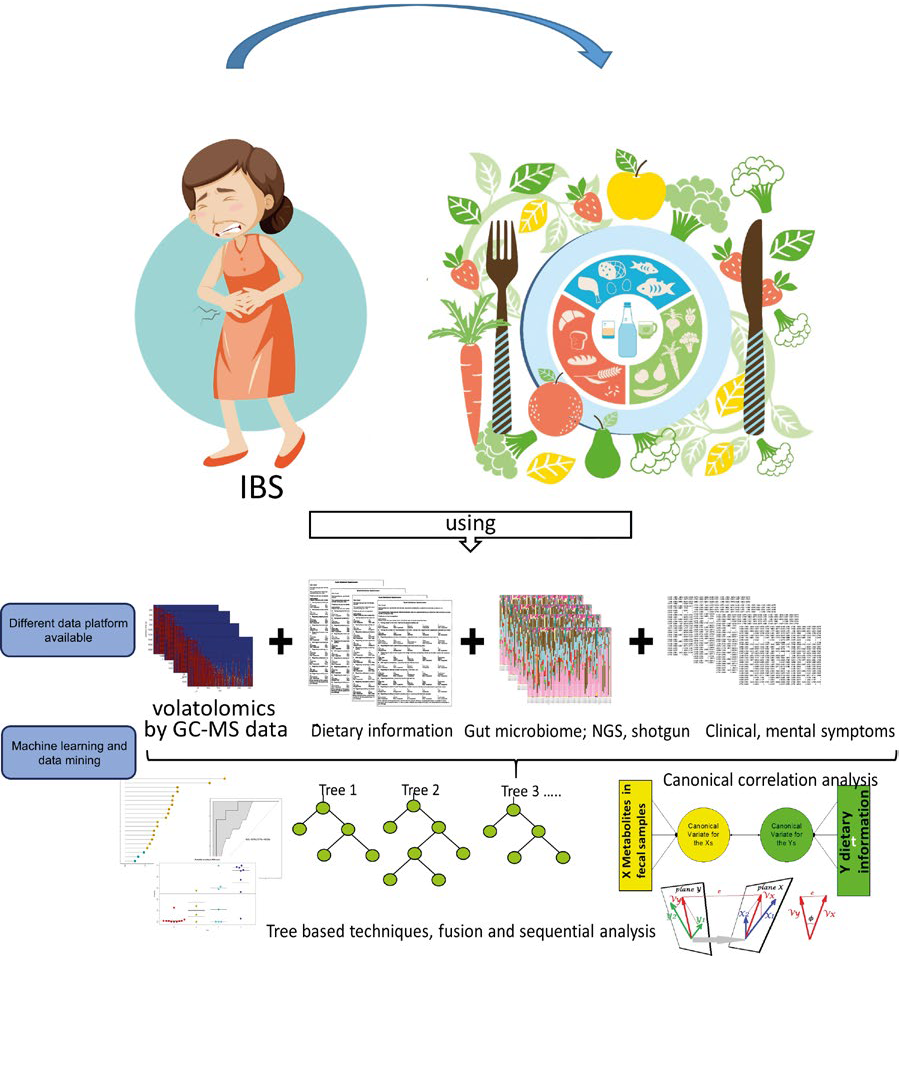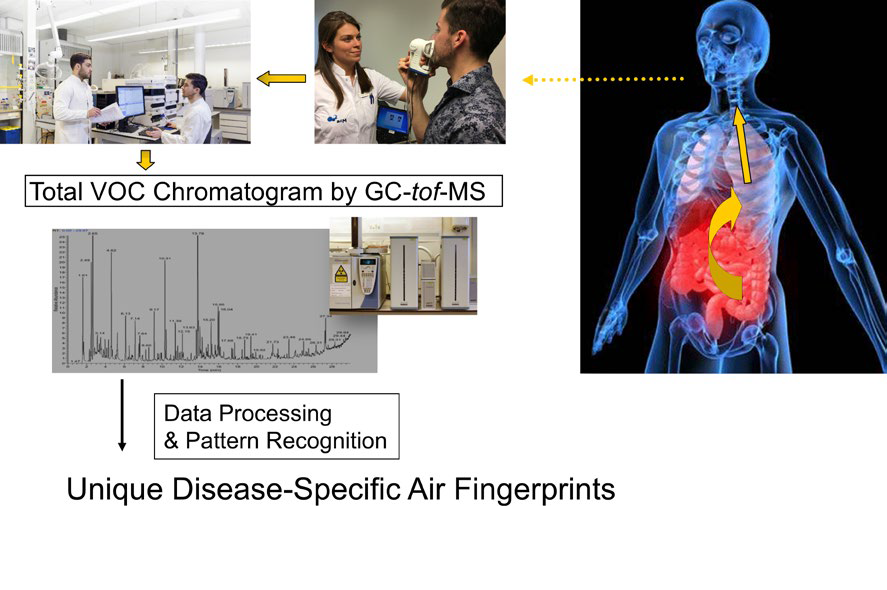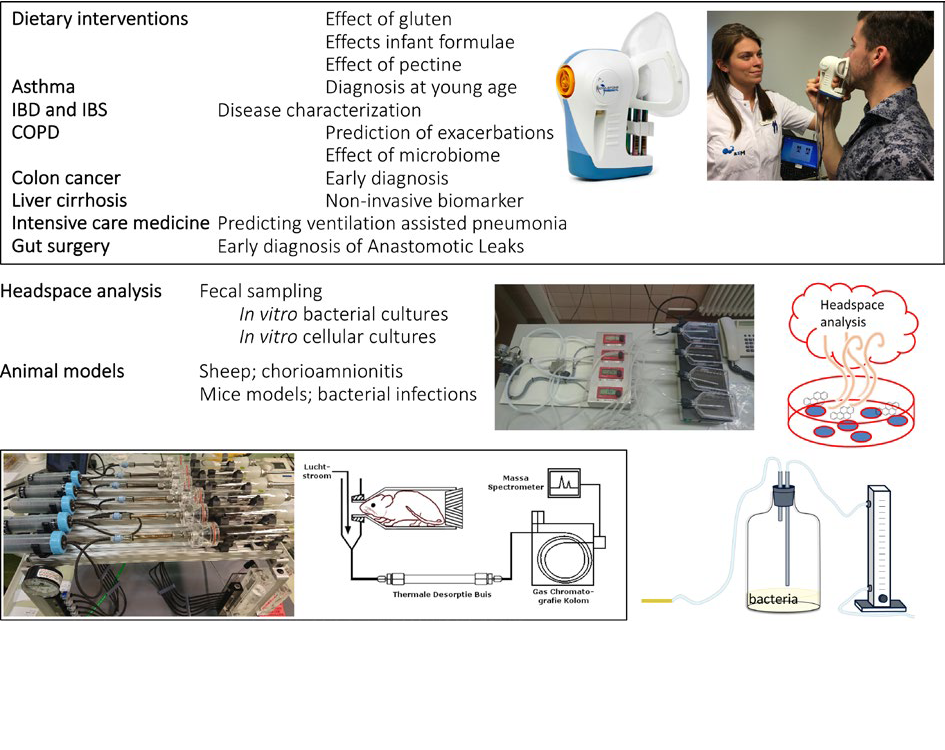Monitoring of disturbed gut by smelling
Division 2: Liver and Digestive Health
Division 3: Respiratory & Age-related Health
Department of Pharmacology and Toxicology and
Department of Internal Medicine
Background
How can odours be an olfactory indication of an individual’s metabolic status?
In ancient times, Greek and Chinese physicians already used scents to diagnose diseases since they noted that fetor hepaticus, a fruity smell in exhaled breath, was related to severe liver failure. The reason for this is that a diseased liver generate ketones and sulfurous substances that end up in the bloodstream and make their way to the lungs producing the strong musty smell.
The odours released from a body often function as olfactory indications about the psychological or metabolic status of an individual. A broad range of volatile organic compounds (VOCs) emitted via breath, urine, feces or skin are related to inflammatory processes occurring in a body (Figure 1, below). Emerging advancements within mass spectrometry technology enables the sensitive detection of these volatile metabolites. Emitted VOCs appeare to be promising non-invasive markers of health and various diseases.

Emerging advancements within mass spectrometry technology enables the sensitive detection of these volatile metabolites. Emitted VOCs appeare to be promising non-invasive markers of health and various diseases. At present, metabolic profiling (a.k.a. metabolomics) is a powerful complement in both diagnosis and understanding of the molecular mechanisms involved in disease occurrence, growth, remission and recurrence. Similarly, we study whether volatilomics, as a form of metabolomics, can become a non-invasive and rapid monitoring tool of disease.
How to relate VOCs profiles to disease?
Next to different pulmonary disorders, we focus on monitoring of gut and liver related diseases, including inflammatory bowel disease (IBD), irritable bowel syndrome (IBS), colorectal cancer (CRC), non-alcoholic steatohepatitis (NASH) and primary sclerosing cholangitis (PSC). These studies are conducted in clinical settings in which groups of patients are sampled together with appropriate controls. In these studies we sample exhaled breath with a sophisticated device that captures alveolar air on a sorption carbon tube, of which it’s VOCs content is subsequently measured by advanced mass spectrometry technology. This leads to detection of approximately 1000 VOCs which can be indicative of pathology occurring in human body. The disease specific VOCs, diagnostic profiles, are found with the use of sophisticated machine learning approaches (Figure 4).

The important aspect of discovering promising biomarker profiles is the proper validation of the outcomes in independent sampled patient cohorts and checked for their performance in sensitivity and specificity. Along these advanced machine learning lines, the clinical studies are supported with bacterial and cellular in vitro models, and experimental animal studies to understand the physiological origin of volatile metabolites (Figures 2-3). Of special interest is the gut microbiome and more specifically the host-microbiome interaction. The microbial composition and function is driven by diet and this can be reflected in VOCs composition in breath and feces.


Major breakthroughs
Numerous external influences hamper the application of breath analysis and standardization of sampling is crucial.
A major breakthrough comes from the ReCVIA sampling device developed for that purpose within the breath-free community and the UK company Owlstone Medical.
Furthermore, we showed the influence of several confounding factors on the exhaled breath composition, including knowledge how diet effects the content of exhaled breath. Further, we show strong correlations between VOCs in exhaled breath and various bacteria in the gut. Certain breath volatiles including SCFAs are explained by the presence of gut bacteria and the interaction with host metabolism. This opens avenues to enhance our understanding of gut disorders and the diet-microbiome-host interaction by combining microbiomics, metabolomics, dietary assessment and clinical manifestation.
Users and collaborations
Because of our expertise and leadership in the field, there are many excellent national and international collaborations, including International association on breath research, Owlstone Medical, Interscience VB, Fraunhofer-Institute for Process Engineering and Packaging IVV (Germany), The Academic Medical Center in Amsterdam, UMC Groningen, University of Antwerp (Belgium), University of Lille (France).
Scientific impact/Research quality
The developed VOCs platform, connected with the preprocessing of the raw data and subsequent data analysis to discover biomarkers of health and diseased organs, is unique in its kind locally and (inter)nationally. Since we started with this research in 2007, many (pre) clinical groups showed interest to collaborate and the applications have been diverse with a high scientific output of more than 50 high-impact peer-reviewed publications (a selection is provided below). Members of the group are active in the International Association of Breath Research (IABR) and in 2018, we organized the IABR Breath Summit in Maastricht. Further, the results of our research have been presented at numerous conferences and received various Young Investigator Awards in the field of breath research.
- Wilms E, An R, Smolinska A, Stevens Y, Weseler AR, Elizalde M, Drittij MJ, Ioannou A, van Schooten FJ, Smidt H, Masclee AAM, Zoetendal EG, Jonkers DMAE. Galacto-oligosaccharides supplementation in prefrail older and healthy adults increased faecal bifidobacteria, but did not impact immune function and oxidative stress. Clin Nutr. 2021;S0261-5614(21)00002-9. https://pubmed.ncbi.nlm. nih.gov/33509667 [IF:6.4].
- Smolinska A, Baranska A, Dallinga JW, Mensink RP, Baumgartner S, van de Heijning BJM, van Schooten FJ. Comparing patterns of volatile organic compounds exhaled in breath after consumption of two infant formulae with a different lipid structure: a randomized trial. Sci Rep. 2019;9(1):554. https://pubmed.ncbi.nlm.nih.gov/30679671 [IF:4.6].
- Smolinska A, Tedjo DI, Blanchet L, Bodelier A, Pierik MJ, Masclee AAM, Dallinga J, Savelkoul PHM, Jonkers DMAE, Penders J, van Schooten FJ. Volatile metabolites in breath strongly correlate with gut microbiome in CD patients. Anal Chim Acta. 2018;1025:1-11. https://pubmed.ncbi.nlm.nih. gov/29801597 [IF:6.0].
- Blanchet L, Smolinska A, Baranska A, Tigchelaar E, Swertz M, Zhernakova A, Dallinga JW, Wijmenga C, van Schooten FJ. Factors that influence the volatile organic compound content in human breath. J Breath Res. 2017;11(1):016013. https://pubmed.ncbi.nlm.nih.gov/28140379 [IF:2.9].
- Smolinska A, Bodelier AG, Dallinga JW, Masclee AA, Jonkers DM, van Schooten FJ, Pierik MJ. The potential of volatile organic compounds for the detection of active disease in patients with ulcerative colitis. Aliment Pharmacol Ther. 2017;45(9):1244-1254. https://pubmed.ncbi.nlm.nih. gov/28239876 [IF:7.5].
- 6. Baranska A, Mujagic Z, Smolinska A, Dallinga JW, Jonkers DM, Tigchelaar EF, Dekens J, Zhernakova A, Ludwig T, Masclee AA, Wijmenga C, van Schooten FJ. Volatile organic compounds in breath as markers for irritable bowel syndrome: a metabolomic approach. Aliment Pharmacol Ther. 2016;44(1):45-56. https://pubmed.ncbi.nlm.nih. gov/27136066 [IF:7.5].
Societal impact
Disorders such as IBD and IBS affect large numbers of people in the general population, severely impact their quality of life, lead to health care costs and indirect societal costs.
The target group, health care providers, the food industry and patient societies, are highly interested, to improve health by dietary adjustments. Defining these adjustments, require biomarker panels able to predict and monitor the response to diet. Furthermore, the results of our developed VOCs platform are of great value to build on diagnostic clinical tools and we are collaborating intensively with the innovative UK Company Owlstone Medical to achieve this goal. We are actively collaborating in projects on colorectal cancer, pediatric asthma, and liver cirrhosis. We are regularly contacted by various groups and journalists who disseminate our research results, unsolicited, illustrating the interest in this topic of the general community.
Who is involved?
The VOCs research group within NUTRIM is highly multidisciplinary consisting of clinicians, chemical, biomedical and data scientists. This multidisciplinary approach allows for integration of data and expertise to unravel the complex diet-microbiome-host susceptibility interaction in relation to intestinal health and wellbeing. In that respect, the research is truly a team effort. At present, the team includes totally of two expert technicians, research nurses, and seven PhD students.
The research takes full advantage of excellent patient and population cohorts from the Department of Internal Medicine, comprising of IBS and IBD patients, and is a synergistic collaboration with scientists of the Department of Pharmacology and Toxicology with outstanding accomplishments in the field of breath research. Prof. van Schooten and Dr. Smolinska have a multidisciplinary profile in analytical measurements, statistical analysis and biochemical interpretation.
Dr. Smolinska’s expertise covers breath, fecal and in-vitro headspace analysis by mass spectrometry technology and data mining including machine learning techniques and data fusion strategies.
Dr. Mujagic is a clinical researcher highly experienced in IBD and IBS, metabolomics, gut microbiomics and dietary influences on diseases courses.
Prof. Jonkers has specific expertise in intestinal health, microbiota and diet, with a strong translational approach. Additionally, the development of the VOCs platform resulted in unexplored collaborative efforts with several clinical groups in the MUMC+ to study VOCs in relation to various diseases (Figure 3), for example Respiratory Medicine, Respiratory Pediatrics, Surgery, Gastro-enterology and Hepatology, Immunology, Medical Microbiology, Human Biology.
The group has been successful in the acquisition of many research funding from international and national institutions, NWO, ZON-MW, Dutch Cancer Society, EU, MLDS, TIFN and NVWA.
Future perspectives
In the future, we aim to get a better understanding of gut health, the interplay between diet, altered microbiota and state-of-the-art metabolomics and volatilomics. To achieve this aim we will make use of the multidisciplinary approach (Figure 4). Additionally, we will make use of our mouse breath sampling device to study in more depth the relation between metabolic pathways, gut microbiome and volatile metabolite.